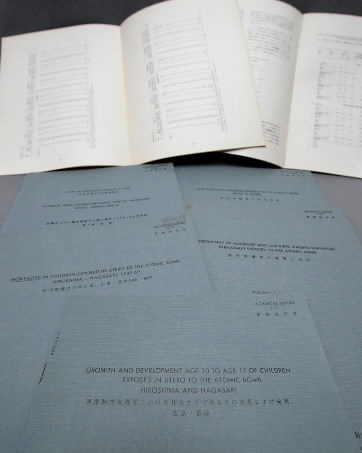A-bomb Microcephaly: The Lives of Patients, Part I [4]
Jun. 29, 2010
Joining the Mushroom Club, sharing worries
by Masaki Kadowaki, Staff Writer
When a woman is exposed to a high dose of radiation in the early stage of pregnancy, the baby's head can be abnormally small in size, resulting in mental and physical disabilities. The condition is known as A-bomb-caused microcephaly. The Ministry of Health, Labour and Welfare has granted official certification to 22 patients of this disease (as of the end of fiscal 2003). Many of the patients and their family members hoped to increase understanding of the condition, but at the same time, have felt fear of encountering prejudice and so wound up withdrawing to the margins of society. Sixty years have passed since the atomic bombing. [This series was originally published in July 2005.] Before the memories borne of that day fade, let us pass on the experiences of the bombing by tracing the personal history of one family affected by microcephaly.
In the 1950s, the Hiroshima-based Atomic Bomb Casualty Commission (ABCC) began conducting research on people who were exposed to the atomic bomb while still in their mother's uterus. Through the research papers produced by the ABCC and studies by local doctors, the medical community knew early on that there were microcephalic patients with mental disabilities. Researchers called the patients "in utero."
A report titled "In Utero," which means "in the uterus" or "before birth" in Latin, is included in a book titled "Kono sekai no katasumi de" ("In a Corner of the World"), written by Hiroshima journalists and authors and published by Iwanami Shoten in 1965.
Toshihiko Akinobu, 70, a resident of Saeki Ward, Hiroshima and a former employee of the RCC Broadcasting Company, still speaks with emotion about ABCC's research. In a quivering voice, he said, "The parents of the microcephalic patients weren't even informed by the ABCC that their children's condition was caused by the atomic bomb. They were simply forced to have their children undergo examinations without being told that there were other people suffering under the same circumstances."
Mr. Akinobu searched for and identified the patients listed anonymously or under pseudonyms in medical papers released by the ABCC. In his report, he bluntly detailed their distress, emphasizing the fact that these patients suffer from a condition which is emblematic of an unwarranted health hazard.
With other supporters, Mr. Akinobu encouraged the parents to rally together and, in 1965, the Mushroom Club was founded with the following aims: advocating for microcephaly to be designated an official A-bomb disease, gaining life-long security for the patients and their parents, and promoting the total abolition of nuclear weapons. Two years later the group's efforts bore fruit when microcephaly was officially listed among designated A-bomb diseases under the Atomic Bomb Medical Relief Law as "short-distance early prenatal exposure syndrome" caused by radiation from the atomic bomb.
But to the mother and the daughter living in Kitakyushu, this information was not immediately accessible. In 1995, half a century after the bombing, they moved to Hiroshima. In March 1996, they joined their first gathering of the Mushroom Club, a party to celebrate the members' 50th birthdays.
They felt nervous at first, but a female patient who had been a member of the club for ten years, started talking to them. This patient, who would eventually become the daughter's best friend, did not know her condition was caused by the atomic bomb until she joined the club.
She understood the hardships the mother and the daughter went through living outside of Hiroshima for half a century. The daughter did not leave her home very often in the past, but the female friend began taking her out. The two confided their worries about their physical conditions. The daughter remarked, "The Mushroom Club gives me emotional support. The members are my true friends. But we have fewer people attending the gatherings now, and it makes me sad."
The patients will be 60 years old next spring. The club had 22 families at its peak, but now has 17 families as of March. The mother, who will be 84 this year, is comparatively young among the parents of the patients. The other parents, on average, are in their late 80s.
(Originally published on July 14, 2005)








